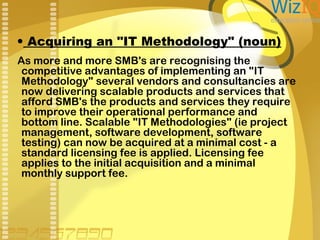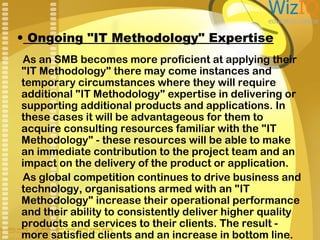Boost your bottom line with scalable it methodologies
- 1. Boost Your Bottom Line with Scalable IT Methodologies
- 2. As world market conditions continue to evolve, so too have the pressures and expectations being placed on organisations. In many cases, the difference between red and black ink can often be attributed to the operational effectiveness derived from the "IT Efficiencies" of the organisation. Since information technology became a part of the business mainstream, business stakeholders, IT practitioners and academia have debated the various and most effective organisational "IT Efficiency" solutions. Though opinions have differed, most concur that an "IT Methodology" is one of cornerstones any organisation can leverage to increase its operational performance and bottom line many agree that an organisation that utilises an "IT Methodology" has a competitive advantage in its ability to deliver and support its products, business applications and day to day operations. For the sake of context, "IT Methodology" can mean different things to different organisations and audiences. As a noun, "IT Methodology" can be viewed as the roadmap users and project teams rely on to consistently deliver products and applications on time and within budget - examples include IBM's Rational Unified Process, PMI's Project Management, assist's Integrated Methodology. As a verb, "IT Methodology" can be viewed as the various modes of travel (practices and techniques) a project team applies while using the roadmap to get to their destination (completed project) - examples include waterfall, agile, spiral, rapid application development RAD.
- 3. As a tool to increase operational performance and bottom line an "IT Methodology" offers the following benefits: • Repeatable Organisational IT Process An "IT Methodology" (noun) can be applied as an organisational process. As a process, organisations are able to define, utilise and repeat a common approach used to develop and support their products and business applications. By utilising an "IT Methodology" as a process, organisations are able to introduce corporate quality assurance (quality products and applications are produced when the process is followed) and organisational improvement (analysing the metrics and measurements of how the process is being used).
- 4. • Consistently Deliver Applications on Time & Budget In being repeatable, an "IT Methodology" (noun) affords organisations reliability in how products and business applications are developed and supported. Project team members (stakeholders, business users and IT) are able to understand their roles and responsibilities, project plans can be defined and approved, and the necessary deliverables and artifacts needed to complete the project can be identified. Applying an "IT Methodology" establishes a degree of structure that project teams leverage (and re-use) to deliver their projects on time and on budget - the more often it is used the more proficient the project team becomes at applying it - the more proficient they become the greater the savings in time and budget.
- 5. • Optimise Communications (Stakeholders, Business Users, IT Project Teams) An "IT Methodology" (noun) acts as the glue that keeps a project team together and working from the same page. This includes project stakeholders, business users and IT project teams. Project Managers are able to dedicate project resources to specific responsibilities and the creation of specific deliverables and artifacts as part of the project plan. Project team members have a clear understanding of their roles and responsibilities. Project team members have a clear understanding of the procedures used to administer the project. Project Stakeholders will have a mechanism to quantify the status of the project team with regard to progress, risks and issues.
- 6. • Incorporate Organisational Governance An "IT Methodology" (noun) provides Senior Management a tool that can provide predictability (schedule, costs, quality) on how IT staff develop and maintain products and applications. This predictability affords Senior Management flexibility to budget and prioritise what applications are to be completed, when they can be completed and what resources will be available to deliver these products and applications. It also provides Senior Management an ability to re-adjust the priorities of the IT resources to reflect the business priorities.
- 7. • Establish Resource Diversity An "IT Methodology" (noun) provides organisations a basis for developing cross-functional expertise in both the business and the IT sides of the house. As a resource becomes more learned on how an "IT Methodology" is applied they can leverage that expertise to become effective in other areas of the business (ie an apprentice carpenter that has learned to use a hammer to build a dog house can rely and re-use that same knowledge when building a deck or a house). This offers flexibility in how resources are to be applied and offers staff an avenue to gain additional expertise and knowledge in other areas of the business. Though the concept of increasing operational performance and bottom line through an "IT Methodology" may be obvious, there remains a huge gap in how various organisations are able to implement these solutions. Large sized organisations have traditionally relied on large sized IT tool vendors and consultancies to acquire and implement complex and all-encompassing "IT Methodology" solutions - in the majority of cases they have created internal project management offices (PMO's) specifically dedicated to implementing and supporting these "IT Methodologies". Small and mid-sized business' (SMB's) have not always had the same financial flexibility nor the same need to acquire and implement these elaborate and all-encompassing "IT Methodology" solutions offered by the large sized IT tool vendors and consultancies.
- 8. In today's world, SMB's are being squeezed from many directions and must rely on their ingenuity and nimbleness to navigate through these challenging realities. All too often the difference between an SMB keeping its doors open and an SMB making a profit is a direct result of its operational performance and "IT Efficiency" - more specifically, on whether or not it utilises an "IT Methodology". Although benefits can be derived from an "IT Methodology", SMB's must assess the other side of the ledger in the ROI equation - implementation requires addition considerations. They include: • Access to "IT Methodology" (noun) Traditionally SMB's have had limited options in acquiring an "IT Methodology". Their only alternatives were (a) acquiring the complex all encompassing solutions offered by the large tool vendors and consultancies (b) not acquiring the complex all encompassing solutions offered by the large tool vendors and consultancies. The costs associated with acquiring these elaborate all-encompassing products and services are often too great for most SMB's.
- 9. • Acquiring an "IT Methodology" (noun) As more and more SMB's are recognising the competitive advantages of implementing an "IT Methodology" several vendors and consultancies are now delivering scalable products and services that afford SMB's the products and services they require to improve their operational performance and bottom line. Scalable "IT Methodologies" (ie project management, software development, software testing) can now be acquired at a minimal cost - a standard licensing fee is applied. Licensing fee applies to the initial acquisition and a minimal monthly support fee.
- 10. • "IT Methodology" Implementation Upon acquiring an "IT Methodology" SMB's must go through the exercise of having it customised (scaled) to ensure it is optimised to contribute to both operational performance and bottom line. Though implementing an "IT Methodology" is unique to every organisation, most SMB's will incur costs associated with customising the "IT Methodology" to their specific circumstances, training the staff on the applying the "IT Methodology" and coaching the staff through several initial projects.
- 11. • Ongoing "IT Methodology" Expertise As an SMB becomes more proficient at applying their "IT Methodology" there may come instances and temporary circumstances where they will require additional "IT Methodology" expertise in delivering or supporting additional products and applications. In these cases it will be advantageous for them to acquire consulting resources familiar with the "IT Methodology" - these resources will be able to make an immediate contribution to the project team and an impact on the delivery of the product or application. As global competition continues to drive business and technology, organisations armed with an "IT Methodology" increase their operational performance and their ability to consistently deliver higher quality products and services to their clients. The result more satisfied clients and an increase in bottom line.












